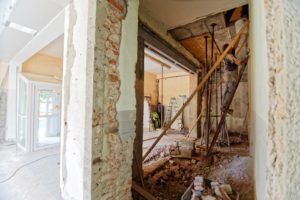8 Steps for a Complete DIY Project Budget Prep
- January 13, 2020
- •
- by Columbia Forest Products
You’re starting a new DIY construction project. That’s great! But sticking to a budget can be tough. Understanding the key factors that heavily factor into a construction project’s cost will help your budget — and project — go to plan.
 1. Communication Is Key
1. Communication Is Key
Communication — with yourself and any project partners — is critical to staying on budget. What is it that you’re looking for? What are the needs versus the wants? Asking yourself and any partners these questions will help avoid problems during the execution of the project.
Problems cost money. That’s why it’s important to set expectations and desired end-goals at the outset. This applies to both yourself and any team member you may bring on board, such as family, friends or hired help. Pull out a pencil and paper (or share relevant documents digitally), go through all the aspects of the project and have regular check-ins to make sure you aren’t going over budget.
Determining what you want the outcome of the project to be will not only help identify all components of the project, and therefore making budgeting a lot easier, but it will also create a clear agreement that all parties can stick to. This can save on a lot of errors caused by miscommunication.
Task software can help keep communication open, and there are plenty of free versions available. To learn about some of the free options, click here.
2. Do Your Research
This may seem obvious, but you’d be surprised at the amount of info you may not know. You can’t know what you don’t know! Doing your research will help you determine not only what it is that you want, but what you can afford. Some products might be inexpensive, but how long will they last? Will you be satisfied with the final results? Sometimes the less expensive options end up costing you more down the line.
There’s a plethora of information at your fingertips, and figuring out a ballpark figure for your particular project will help you solidify a baseline for your budget. Researching other projects similar to yours will help you get a better sense of what you need to consider. Reading blogs such as this will help you determine what products are best for you.
3. Create a Spreadsheet
Spreadsheets are a great way to keep track of all of the moving parts of a budget and project. Using tools like Google Sheets can help you keep track of everything, so you can focus on getting the job done. Sheets is also available as an app so you can keep track of your budget while on the go, and it’s easy to share with anyone else who needs the information.
When outlining a budget on your spreadsheet, it’s important to outline both the expected budget and actual expenditures. Keeping track of costs can help you anticipate any shortfalls or issues that might arise and help you adjust on the go. Plus, some of these expenses might be valuable write-offs (see below).

4. Budget for All Aspects of the Project
Yes, this includes the small things that are often overlooked and can make up a larger than expected chunk of expenses. Things like small tools and hardware can inflate the cost of the project budget.
Alternative living arrangements like hotels represent other costs you might encounter. Depending on the type of project, critical areas of your home may be inaccessible, leaving you unable to go about your daily life. This may also include transportation and meal costs not previously considered.
Not budgeting for all the aspects of the project can impact the overall financial impact of the project, causing unnecessary delays and stress.

5. Investigate Rebates or Tax Credits
While this may not immediately impact the budget, rebates for green renovations or home improvement tax credits can be helpful if you are financing a project. Lending institutions are more likely to offer financing if there’s a rebate involved.
Some regions offer different types of rebates and a quick internet search can help you determine this. Find out more information about rebates here.
6. Prepare for the Unexpected
How often have we heard stories of construction projects taking unexpected turns and causing delays? If you think this won’t happen to you, you might want to think again.
Renovations and DIY projects have that funny way of not going to plan more often than not, so being prepared financially will save you a lot of headache and heartache if the project is financially stalled. It’s best to budget an extra 10 percent for those just-in-case situations and always refer to an alternative plan.

7. Always Have a Plan B
This goes hand-in-hand with preparing for the unexpected. In this case, the unexpected can be resorting to a backup plan. Clearly articulating and budgeting for a plan B at the outset will not only cut wasted time but will help you stay within your cost expectations.
8. Don’t Budget for Additional Home Value Long-Term
It may seem logical that adding value projects to your home is always a smart move. And in some cases, they are. But unless you plan on selling right away, value-added remodeling shouldn’t be factored into your budget. After all, you may have redone your kitchen 20 years ago, but a 20-year-old kitchen is considered by most an old kitchen.
Unless you plan to sell within the next 2-3 years, don’t count on the extra value added to your home.
Get Started Today
Starting a new construction project can be intimidating, but it doesn’t have to be overwhelming. By keeping these points in mind, you can begin your project with confidence, ready to face any obstacle.
And if you’re looking for design inspiration for your project, be sure to check out our blog by clicking here.




